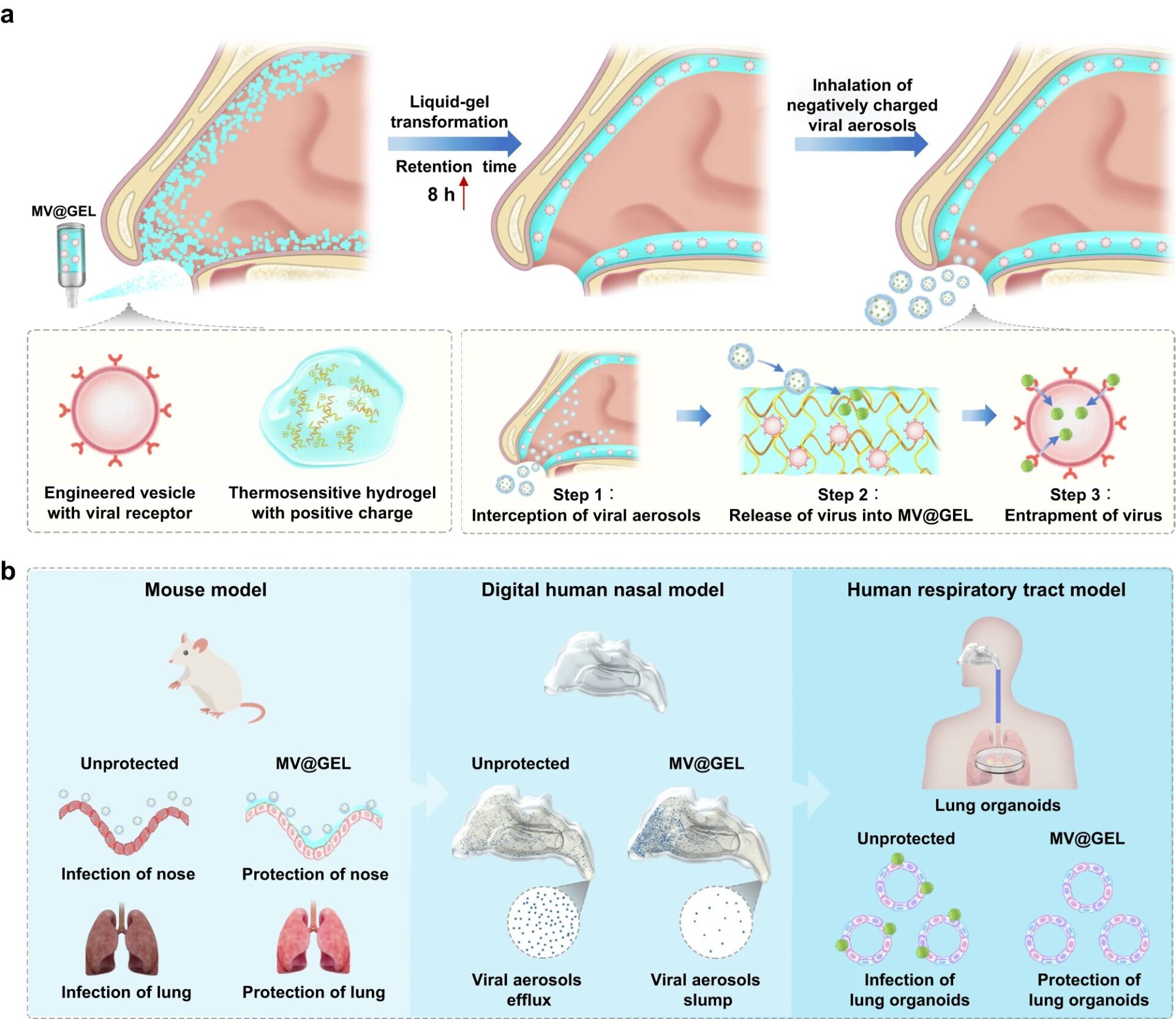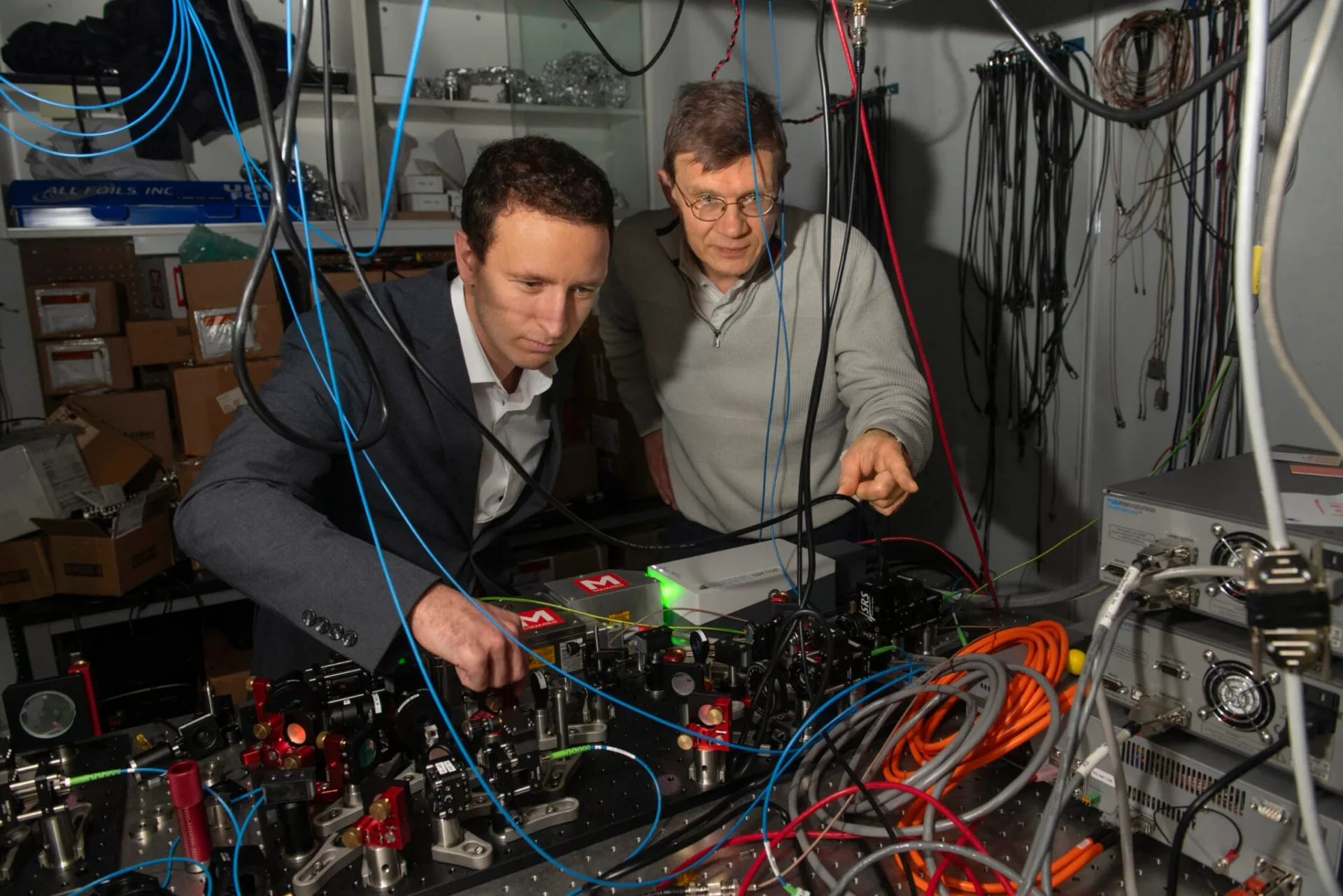
Schematic and experimental design for MV@GEL as an intranasal mask to intercept viral aerosols and entrap virus. a The intranasal mask (MV@GEL) was composed of engineered cell-derived microsized vesicles (MV) with viral receptor and thermosensitive hydrogel with positive charges. It could be sprayed into the nasal cavity at room temperature and quickly transformed from the liquid state to the gel state at body temperature. The viral receptor of vesicles could help vesicles entrap the virus, and the thermosensitive hydrogel could prolong the retention time of vesicles in the nasal cavity. Once the negative viral aerosols were inhaled, the intranasal mask could perform the protective effect in the following steps: Step 1, the positively charged hydrogel could intercept the negatively charged viral aerosols presenting in airflow; Step 2, those viral aerosols could fuse with MV@GEL and release viruses into MV@GEL; Step 3, the embedded MV in MV@GEL could entrap those released viruses. b The protective effect of the intranasal mask was investigated from the following three aspects. 1. Mouse model: MV@GEL conferred strong protection against viral aerosol infection in the mouse nose and downstream lung; 2. Digital human nasal model: based on computerized tomography (CT) images of the human nasal cavity, computational fluid dynamics (CFD) simulation supported that viral aerosols could be intercepted in the human nasal cavity under MV@GEL protection; 3. Human respiratory tract model: connecting a realistic human nasal apparatus with human lung organoids and providing respiratory airflow by the pump; the human respiratory tract model was constructed and utilized to demonstrate the good performance of MV@GEL in protecting the lung organoids from viral aerosols.
Credit: Nature Communications (2023). DOI: 10.1038/s41467-023-44134-w
Researchers from two State Key Laboratories in Institute of Process Engineering (IPE) of the Chinese Academy of Sciences have developed a novel intranasal mask to protect the respiratory tract from viral aerosols. It showed satisfactory protection in mouse model, digital human nasal model and human respiratory tract model.
The study was published in Nature Communications.
Respiratory infectious diseases massively impact global public health. The spread of these infectious diseases substantially relies on the transmission of aerosols to the respiratory tract. Utilizing face masks has been an important public health effort to reduce the rates of respiratory infections. However, the effectiveness of face masks is not sufficient for high-risk individuals.
To increase protection against viral aerosols, the researchers designed an intranasal mask (MV@GEL) that comprises a positively charged thermosensitive hydrogel and cell-derived microsized vesicles featuring viral receptors.
“The intranasal mask can be sprayed into the nasal cavity at room temperature and quickly transforms from the liquid state to the gel state at body temperature. Inside the nasal cavity, the positively charged hydrogel can intercept the negatively charged viral aerosols that present in the airflow, while the receptor on the vesicles can interact with the virus that is released from viral aerosols to MV@GEL, thereafter mediating the entrapment of virus for inactivation,” said Prof. MA Guanghui from IPE.
Upon displaying matching viral receptors, the intranasal masks showed satisfactory protection of the nasal cavity and lungs of mice from either SARS-CoV-2 aerosols or influenza A virus aerosols.
Using computerized tomography images of the human nasal cavity, researchers constructed a digital human nasal cavity model with which to conduct a computational fluid dynamics simulation.
“The simulation result showed that the intranasal mask could intercept 93.2% of viral aerosol particles in the nasal cavity, thus preventing those viral aerosol particles from entering the downstream lung,” said Prof. WANG Limin from IPE.
Additionally, researchers used 3D printing technology to fabricate an apparatus simulating the human nasal cavity. It was then connected to a culture of human lung organoids and provided respiratory airflow by a pump, thus serving as an integrated human respiratory tract model.
Using this integrated model, which anatomically replicated a human nasal cavity and closely mimicked infection in the human lung, researchers confirmed the potent protection offered by MV@GEL against viral aerosols and the great suitability of an intranasal mask in humans.
“The intranasal mask in our study can provide broad protection against multiple viral variant aerosols. This is because the binding of virus and viral receptor is independent of mutation,” said Prof. WEI wei from IPE. “Considering the viral receptor on the vesicle could be engineered easily, our MV@GEL system has the promising potential to be a flexible platform against various viral aerosols.”
A peer reviewer from Nature Communications called the research “very interesting and exciting” and said that “the proposed strategy could significantly improve the prevention of these infectious diseases and have a high impact on public health.”
Original Article: Pitt ChemE Researchers Design Active Materials for Self-regulating Soft Robots
More from: Chinese Academy of Sciences
The Latest Updates from Bing News
Go deeper with Bing News on:
MV@GEL
- Mother mistakes shower gel for olive oil while cooking chicken
Julia Roberts' delicious obsession: The ultimate chocolate chip cookies! A mother’s unfortunate cooking incident left her dinner a bit too soapy. In a viral 3 April TikTok video, Kameron Jane ...
- ‘Twilight Haze’: Vineyard-inspired visions
Young’s arresting exhibit is more than a visual experience. Her show, curated by Featherstone Center for the Arts at the Feldman Family Artspace in the MV Film Center, teems with arresting, ...
- Illinois AG piles onto troubled brokerage MV Realty’s legal woes
MV Realty and one of its founders Amanda Zachman, whose real estate brokerage is accused of deceptive business practices in at least nine other states, now faces a lawsuit from Illinois Attorney ...
- 2024 MV Agusta Superveloce S Ride Review: Ferocious Flair
The MV Agusta Superveloce is a neo-retro masterpiece with the performance and electronics of a contemporary sportbike. MV Agusta's neo-retro Superveloce pays homage to the glory days of Grand Prix ...
- Aruba Aloe hand sanitizer and gel recalled nationwide after methanol found
Aruba Aloe Balm is recalling Aruba Aloe Hand Sanitizer Gel Alcohol 80% and Aruba Aloe Alcoholada Gel, which is sold across the U.S., after finding methanol in the products. Substantial exposure to ...
Go deeper with Bing News on:
Intranasal mask
- Can nasal Neosporin fight COVID? Surprising new research suggests it works
A potential treatment for COVID-19 may have been hiding in our medicine cabinets, a new study in PNAS has found ...
- Why Experts Are Worried About Bird Flu in Cows
Health officials have detected fragments of a bird flu virus in milk. What does that mean for the milk supply?
- Can Neosporin Protect You From Getting COVID-19?
A small study recently published in PNAS presents a similar, if lower-tech, idea. Coating the inside of the nose with the over-the-counter antibiotic ointment Neosporin seems to trigger an immune ...
- ResMed reports double-digit mask revenue
ResMed reported revenue of $1.2 billion for the third quarter of fiscal year 2024, a 7% increase compared to the prior year period.
- F&P launches AutoFit segment
Fisher & Paykel Healthcare hosted a webinar this week to highlight the launch of its F&P Solo Nasal mask in the U.S.










